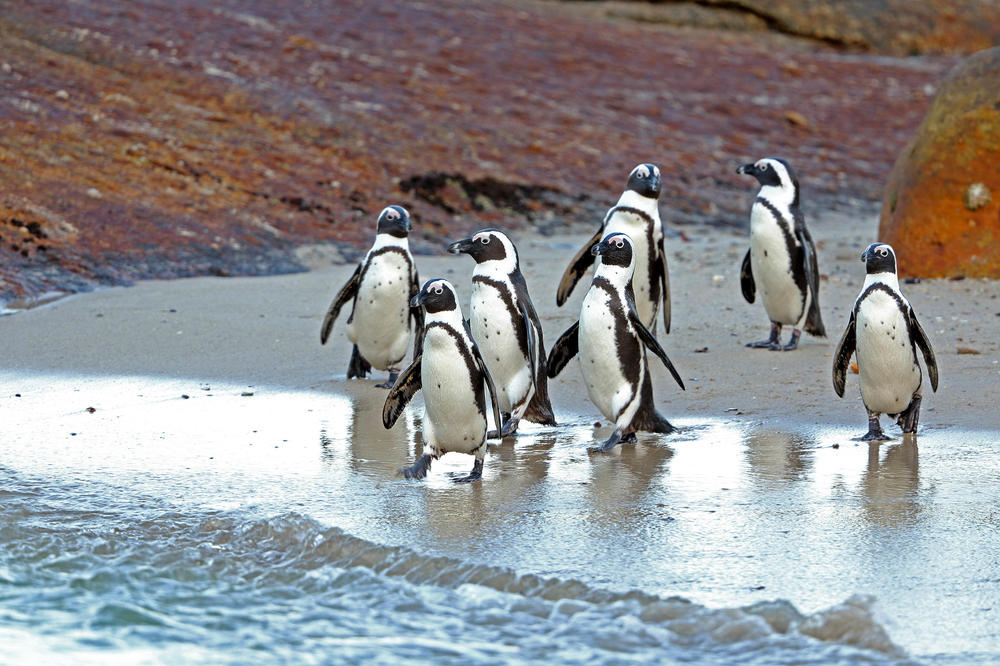The Last of Their Kind
An international project to protect the African penguin aims to find common ground between ecological and economic interests
May 21, 2021
Wading into the water for a swim – and a snack. Researchers are investigating how they can protect the African penguin, an endangered species.
Image Credit: picture alliance / blickwinkel / M. Woike
Back in the 1980s, there was only one breeding couple of African penguins on Boulders Beach, a little under an hour’s drive from Cape Town. Something of a success story has been gradually unfolding since that fateful day. Thanks to ongoing conservation efforts, the colony has now grown to an incredible 2,500 birds.
Fighting for Survival
The African penguin, which stands at a height of between 60 and 70 centimeters and sports a striking black-and-white pattern, is among the few species of penguin that are native to warmer climates. These marine birds are spoiled for choice with plentiful fish reserves on the coasts of Namibia and South Africa, and protected conservation areas where they can breed and raise their young.
But how long this golden age will last remains to be seen. Although the colony on Boulders Beach has grown leaps and bounds in recent decades, the overall African penguin population has found itself in dire straits. Experts estimate that the population has declined by as much as 95 percent in the last 100 years, and they warn that the species could die out in just 30 years. “We need to act now if we want to prevent this from happening,” says Marcus Doherr. The professor for veterinary epidemiology and biostatistics at the Department of Veterinary Medicine, Freie Universität Berlin is participating in an international research project dedicated to conserving African penguin colonies.
The overarching idea of the project is to marry economic and ecological interests, a concept otherwise known as the “blue economy.” In this case, the focus lies on protecting the marine ecosystem while also promoting economic growth. The project, which will run until September 2022, is supported financially by the “MeerWissen” initiative of the German Federal Ministry for Economic Cooperation and Development.
The program fosters collaboration between African and German marine scientists and stimulates dialogue and the transfer of knowledge between researchers and policy-makers. “Our goal is to compile the knowledge necessary to achieve our objectives and pinpoint strategies that will allow us to secure the survival of the penguin in the long term,” explains Doherr. Freie Universität Berlin’s partners in the project are the University of Pretoria, the University of the Western Cape, and the University of Namibia.
The African penguin was classified as endangered by the International Union for Conservation of Nature back in 2009. The reasons for the species’ decline include the growing human population, overfishing, and water pollution, as well as oil spills. “As epidemiologists it’s our duty to identify factors that could threaten the penguin population’s survival. This allows us to investigate which parameters we can adjust together with all interest groups so that the populations can recover,” says Doherr. One measure, for example, could be to establish protective zones around the penguins’ habitats.
Bird Flu, a Further Threat to Penguin Populations
Infectious diseases pose another risk to the African penguin – for example, in 2018 and 2019 bird flu broke out among some South African penguin colonies, resulting in the death of hundreds of birds. Yet little is known about the exact effects of such an illness on the continued existence of the marine birds at present.
“Up to now it was primarily continuous influences like the availability of food that were factored into models tracking potential trends in population development,” says Doherr. This is why researchers now want to develop mathematical simulations for the populations that also factor in the emergence of sudden threats like infectious diseases.
Drones Help in Monitoring the African Penguin
Researchers at the African partner universities are currently collating data that provides information on the pollution to which the penguins are exposed. As part of this work, they have been charged with the rather unpleasant task of taking samples from dead penguins. Doherr says that the birds have to be regularly monitored as they are highly sensitive to changes in their environment: “If we see that the number of breeding pairs declines steeply, then this may indicate that the ecosystem is at risk.”
The researchers have found an innovative solution to this problem to avoid disturbing the penguins in their natural environment: drones. They are also planning citizen science projects to get laypeople involved in conservation of the penguins. For example, people will be asked to count African penguin populations on the mainland from visitor trails and notify the scientists of dead penguins on public beaches. It is hoped that this project will actively engage the local community and encourage them to protect the species.
Waddling Tuxedoed Birds as a Tourist Attraction
One particular challenge that Doherr sees in the project is that it needs to bring together interest groups from politics, business, culture, and society and stimulate a dialogue between them. One could argue, for example, that penguin populations are important to the economy as a tourist attraction – and from this perspective, worthy of protection.
But Professor Doherr thinks it could be possible to prioritize other economic aspects. It is even more important that these interest groups communicate with each other and make decisions in line with the concept of a sustainable economy. “These kinds of decisions are not up to us as researchers. But through our research we can draw attention to how important protecting the African penguins is for the entire ecosystem and thus its significance for the economy,” says Doherr. Together with his colleagues, he hopes that all participants campaign for the well-being of the penguin colonies so that they will one day flourish, just like the population on Boulders Beach.
This text originally appeared in German on April 24, 2021, in the Tagesspiegel newspaper supplement published by Freie Universität.

